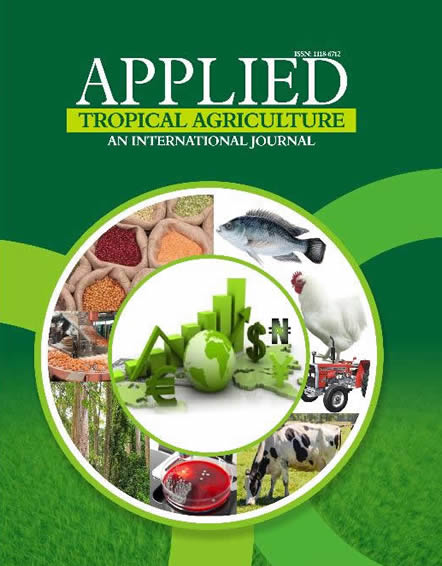PAPER TITLE :POTENTIALS OF RICE HUSK ASH, COWDUNG ASH AND POWDERED CLAY AS GRAIN PROTECTANTS AGAINST CALLOSOBRUCHUS MACULATUS (F) AND SITOPHILUS ZEAMAIS (MOTS)
APPLIED TROPICAL AGRICULTURE | VOLUME 19 NUMBER 1 2014
Paper Details
- Author(s) : Adebayo, R.A.* & Ibikunle, O.
- Abstract:
Experiments to assess the potential of cowdung ash, rice husk ash, and powered clay in the control of Callosobruchus maculatus (F) (cowpea beetle) and
Sitophilus zeamais (Mots) (maize weevil) were conducted at the Entomology laboratory of the Department of Crop, Soil and Pest Management, Federal
University of Technology, Akure, Ondo State, Nigeria from April – July, 2011. The experiment was carried out under laboratory conditions of 28o±2oC
temperature and 55-75% relative humidity. Twenty clean uninfested seeds of cowpea and maize were weighed and placed in petri–dishes to which 1g and 2g of
decarbonized ash of rice husk, cowdung and powdered clay were applied as well as the control. All treatments were replicated three times. Data were taken on
number of eggs laid, number of seeds with eggs, number of seeds with holes, adult emergence and weight loss for C. maculatus while adult emergence, seeds with
holes and weight loss were taken for S. zeamais. The effects of the various concentrations of the treatments on the number of cowpea seeds with C. maculatus
eggs were not significant (P>0.05), though the highest number of eggs was recorded on the control (0g). The lowest number of C. maculatus adults emerged
from seeds treated with cowdung ash, which was significantly different (P<0.05) from that of the control. Significant higher weight loss was recorded on
untreated cowpea seeds which was significantly different from those treated with rice husk ash and cowdung ash. For maize, number of S. zeamais adult
emergence and seeds with holes were significantly different (P<0.05) for all treatments, with untreated seeds yielding the highest number of adults. Significant
differences also existed in the weight loss with highest weight loss observed on untreated maize grains. The study showed that cowdung and rice husk ash as well
as powdered clay performed similarly at different rates and their effects seem to increase with the concentration. These treatments exerted protectant properties on
the treated cowpea and maize grains. It is therefore recommended that higher rates of these treatments be further evaluated.


